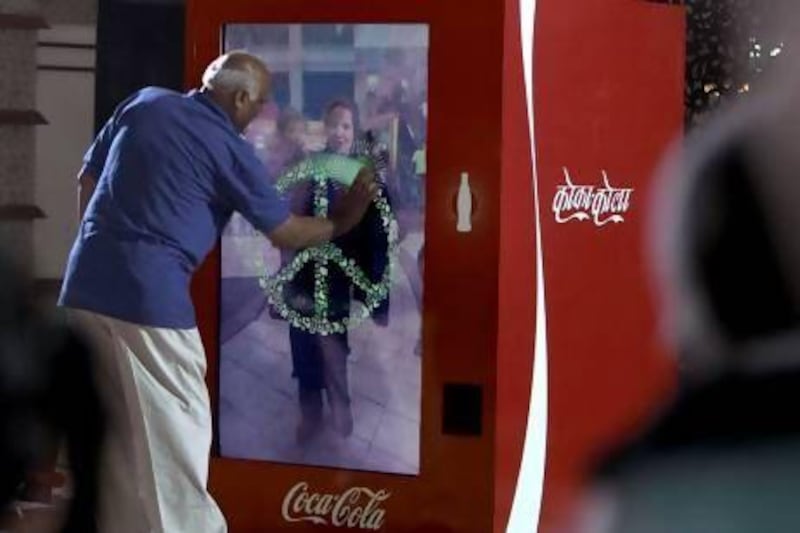Rivalries between countries can make for emotional advertisements, especially when everyday friendly competition glosses over more violent hostilities.
India and Pakistan is a case in point.
The television channel Neo Sports used the competitive element between the two nations to advertise the India-Pakistan cricket series last year. Now Coca-Cola is the latest to use the national rivalry for an advertising campaign titled “Small World Machines".
The countries were the obvious choice for a film thanks to Coke's tagline "Open Happiness", according to the ad makers Leo Burnett.
The three-minute spot shows two vending machines - one in New Delhi, India, and the other in Lahore, Pakistan - connected via a webcam and a giant touchscreen.
Passers-by approaching the machine in one nation could see those at the machine in the other and they could help each other get a free can of fizzy pop if both participated in joint activities, such as drawing matching peace signs or dancing together.
"The idea was connecting conflicting nations and bringing together the people," says Justin Carew, art director at the Sydney office of the advertisement giant. The 31-year-old was one of the five team members who worked on the project from Australia. More than 25 people from the Sydney and Chicago offices of Leo Burnett worked on the ad.
"There has been a lot of differences between India and Pakistan and they had seen conflicts in the past. But a lot of amendments have been made between the two, and there is a lot of familiarity and friendly competition that they get along with."
Last year, Coke unveiled a smartphone app, which enabled consumers to buy strangers a can all around the world. It even won the company the Mobile Grand Prix award for the best ad in the Mobile category at the Cannes Lions International Advertising Festival.
But Leo Burnett's campaign to help strangers in opposing nations is altogether more serious because of the political undertones associated with it.
"The campaign, in its totality, tries to get people to engage in action and that is a strong point — the kiosks that enable people to interact is an important and integral part of the campaign and the consumer engagement through it is important," says Amitava Chattopadhyay, Insead chair professor in marketing and innovation in Singapore.
For a year, the Leo Burnett team fine-tuned technicalities of the machine, which they also designed themselves.
Besides issues such as intermittent power cuts in Pakistan, the team had the challenge of handling a "sensitive, political issue", says Iggy Rodriguez, a copywriter for Leo Burnett in Sydney, who worked with the crew in Pakistan.
Filming was another adventure.
Initially, the event was scheduled to run over three days in Karachi and New Delhi.
However, the first filming leg was postponed after the Leo Burnett team arrived in Karachi in January when the then Pakistani prime minister was under house arrest and there was a flare-up in cross-border tension with India. The team regrouped in March, got machine clearance in both countries, and changed the location in Pakistan to Lahore. While one machine was placed in the Mall of Delhi in Gurgaon, in the outskirts of New Delhi, the other was placed in the Mall of Lahore.
The result: a man in loose, brown salwar kameez draws a heart sign with a woman in a more colourful kurta; a girl and her mother with her head draped in a dupatta trace a peace sign with a boy and her mother, who is dressed in a sleeveless kurti; and a teenage boy and a girl dance away together across the digital window.
And as they do so, they help the other receive a free can of Coke. More than 10,000 cans were dispensed during the three days of filming and at times it was difficult to differentiate which side of the border the images were from. That tug at sentiment: that people across the border are the same despite political mistrust was a hit with 1.56 million people watching the ad on YouTube after it was released in May. It is yet to be broadcast on television.
The "ad speaks to the moderate and more liberal audience in India and Pakistan, who actually share the ideas that are presented in the ad," adds Professor Chattopadhyay.
"It would also work with people who are neutral in their opinion towards the other country."
For those on the ground during the filming process, it was an overwhelming process.
"Many of the Pakistanis had never seen an Indian before and were intrigued by things such as what they wore," Mr Rodriguez says of his experience in Lahore.





